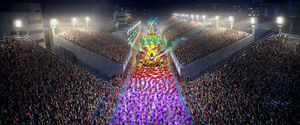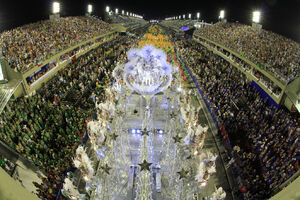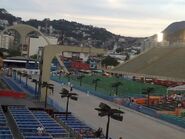| ||||||||||||||||
| [Source] | ||||||||||||||||
Sambadrome Marquês de Sapucaí is a concrete-built stadium located in the City of Rio de Janeiro, specially constructed and designed to host the annual parade of Samba Schools during Rio's Carnival.
Sambadrome Marquês de Sapucaí's first appearance in Rio was right after when Linda, who has been looking for the missing Blu and Jewel with Tulio, accidentally wandered into and got into the back of one of the Carnival's float trucks and lifted up on the upper platform as the truck approached the alleyway. Finding herself in a wrong position, Linda (helped by Tulio) desperately tried to get out of the situation and continue with her search for the two missing Spix's Macaw. At the same time, Blu, Luiz, Rafael, Nico, and Pedro had arrived at the Carnival, chasing after Jewel who was kidnapped by Nigel and caged inside the Smugglers's float. Sliding on one of the dancers' skateboard, Blu finally caught up with the smuggler's truck and went inside, hoping to rescue Jewel, but eventually obstructed and got himself locked up in a cage by Nigel. Linda and Tulio, who finally broke free from the parade and the crowd, luckily spotted Fernando on the truck and went right after the smugglers. When the smuggler's truck was about to leave Sambadrome Marquês de Sapucaí, Linda - realizing the impossibility of running after the truck - stole one of the unboarded float truck and told Tulio to get aboard, driving after Blu and Jewel until they reached the airport.
History and Construction[]
The history of this grand stage dated back in 1984, when it was designed and built by world-renowned architect Oscar Neimeyer. At first, the original plan was to construct Sambrodome Marquê de Supací at Presidenta Vargas Avenue, but later it was advocated that the venue was to be built at the recognizing birthplace of Brazilian Samba, Marquis de Sapucaí.[1]
Construction was completed within only 110 days[1], including stadium-styled seating or 'sectors' erected on both sides of the alleyway. Sambadrome was officially inaugurated on March 2, 1984 - just in time for the inaugural Sambadrome Parade of Rio Carnival.
Description[]
The remarkable venue comprises 13 individual free-standing structures for spectator's viewing called 'sectors' situated on both sides of a 700m long, 13 wide[1] straight alleyway which the parade takes place. The alleyway is also featured with the Apotheosis Square - a square area in which the parade participants can celebrate, gather, and take off their costumes as their parade comes to a close.
Rio 2016 Summer Olympics[]
Archery[]
In 2016 when the Rio 2016 Summer Olympics started, Sambadrome Marquês de Sapucaí hosted all events of the Archery competition including the preliminary qualifying rounds and the Olympic finals.[2]. The venue provided perfect viewing for the spectators thanks to sectors located on both sides of the alleyway where archery competitions took place.
Marathon[]
The Sambadrome also hosted the Marathon event, during which the competitors will start their race, running down the alleyway then continue the course through the city of Rio and return for the finish line of the Marathon.[2]
Renovations and Extension[]
The Sambadrome initially provided seating for around 70,000 spectators when it was completed in 1984, but when it was announced that Rio de Janeiro had won 2016 Summer Olympic bidding in Denmark, there were many concerns over the venue capacity and that the stadium needed to undergo a renovation to increase the seating capacity in preparation for the sporting events in 2016. The capacity has now been raised to 90,000 with new 4 sectors (bleachers) constructed opposite to the pre-existing 4 on the other side of the alleyway.




















